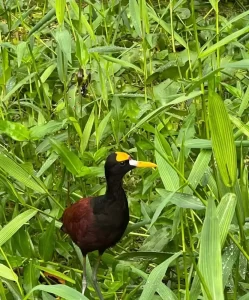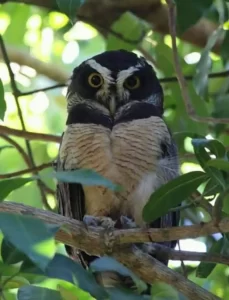Costa Rica is a small country in Central America, but it’s famous all over the world for its amazing nature and wildlife. Even though it only covers a tiny part of the Earth—just 0.03%—it’s home to about 5% of all the plants and animals on the planet! This makes Costa Rica one of the richest places on Earth for biodiversity, which means the variety of living things in one area. Because of this, Costa Rica works hard to protect its nature and keep its ecosystems healthy.
Read our detailed guide If you want to know about the Costa Rica Map Guanacaste Province

The Many Types of Ecosystems in Costa Rica
Costa Rica has all kinds of ecosystems, from dense rainforests and misty cloud forests to dry forests, wetlands, and coral reefs along the coast. Each of these habitats is home to many unique plants and animals, making Costa Rica a place where life thrives in many forms.
Explore exciting activities and trips from your stay in our post on the Best Hotel RIU Guanacaste Costa Rica Excursions for 2024.
Rainforests
Approximately 50% of Costa Rica’s land area is covered by forests, with tropical rainforests being among the most biologically diverse. These forests are home to countless species of plants, mammals, birds, insects, and reptiles.
Cloud Forests
Cloud forests are special forests with high humidity and low clouds that hover over them, creating a damp and misty environment. These unique conditions support many rare plants and animals that can’t live anywhere else. For example, the golden toad and the resplendent quetzal, a colorful bird, thrive in these misty forests. Because of the unique species that live here, cloud forests are very important for biodiversity.
Dry Forests
Costa Rica’s dry forests may not be as famous as rainforests, but they are essential for many species. These forests, mostly found in the northwest, are tropical deciduous forests that go through a distinct seasonal cycle. During the dry season, the trees lose their leaves to conserve water, making these forests a safe home for plants and animals that are adapted to dry conditions.
Wetlands
Wetlands cover about 10% of Costa Rica’s land. They play an important role in keeping the climate balanced, storing water, and providing a safe place for many types of plants and animals. For example, Tortuguero National Park is a famous wetland where sea turtles come to nest and beautiful birds like herons and egrets come to feed. Wetlands are very important for nature and for people.
Coral Reefs
Off the coasts of Costa Rica, in both the Pacific Ocean and the Caribbean Sea, are beautiful coral reefs. These reefs are full of life, with colorful fish, sea turtles, and other sea creatures. Coral reefs are not only home to many species but also help protect the coastline from erosion by breaking big waves before they reach land. This makes them important both for sea life and for keeping coastal areas safe.
Flora and Fauna: A Closer Look at Biodiversity
Costa Rica has an amazing variety of plants and animals, even though it takes up only a tiny part of the Earth’s surface—just 0.03%. This small country is home to about 5% of all the species on the planet!
Flora (Plants)
Costa Rica has over 12,000 different types of plants, including thousands of orchids, strong hardwood trees, and plants that are used for medicine and food. The country’s different climates allow all kinds of plants to grow, making it a paradise for people who love plants and nature.
Mammals (Animals)
Costa Rica is home to about 250 types of mammals. Some of the most famous animals include sloths, capuchin monkeys, and jaguars. National parks across the country give these animals a safe place to live. Visitors often see capuchin monkeys swinging in the trees or spot a slow-moving sloth hanging from a branch.
Remarkable Flora
Rich Plant Diversity
Costa Rica has an amazing variety of plants—over 12,000 types! This includes around 1,400 kinds of orchids. The country’s different climates and heights, from sea level to mountain tops, help create this rich plant diversity.
In the warm lowland rainforests, you’ll find brightly colored flowers like bromeliads, while the cooler cloud forests have special plants like ferns and epiphytes, which grow on other plants. The plant life in Costa Rica is beautiful and diverse.
Medicinal Plants
Costa Rica also has many plants used as natural medicine. For centuries, people in Costa Rica have used these plants to treat health problems. Today, scientists are studying them to see how they can help in modern medicine. One plant, the soursop (or guanabana), is known for its possible health benefits.
Endemic Species
Several plant species are endemic to Costa Rica, including the iconic Costa Rican Oak (Quercus costaricensis) and the unique Monteverde Orchid. These species are crucial for the local ecosystems and serve as essential habitats and food sources for various animals, emphasizing the interconnectedness of flora and fauna in these ecosystems.
Diverse Fauna
Costa Rica is full of incredible animals, with some species found only in this country. Even though Costa Rica takes up just a tiny part of the Earth—only 0.03% of its surface—it has about 5% of all the world’s plants and animals. Let’s look at some of the amazing animals that live here.
Birds
Costa Rica is a dream destination for bird lovers, with over 900 different bird species. Some famous birds include the resplendent quetzal, known for its bright colors and long tail feathers, and the harpy eagle, one of the biggest and strongest eagles in the world. Costa Rica’s different habitats, from rainforests to mountains, support this huge variety of birds. Each national park offers a unique place to see these beautiful creatures.
Reptiles and Amphibians
Costa Rica is a great place for people who love reptiles and amphibians, with about 220 types of reptiles and over 175 types of amphibians. Some well-known creatures are the red-eyed tree frog, green iguanas, and the rare basilisk, which can run on water! These animals are important in nature because they keep the balance by being both hunters and food for other animals.
Conclusion
Costa Rica is a perfect example of why protecting nature is important. Although it covers only a small area, Costa Rica holds around 5% of all the world’s plants and animals. This shows how many different species and ecosystems can live together, creating a rich and balanced environment that’s worth protecting.
The rich tapestry of life that exists here—ranging from unique flora and colorful avian species to a plethora of reptiles and amphibians—not only contributes to the planet’s biodiversity but also supports local communities and economies through ecotourism and sustainable practices.
As environmental problems grow around the world, Costa Rica stands out for its dedication to protecting nature. The country has a strong national park system and many programs to protect its unique plants and animals. Costa Rica’s efforts show other countries how to balance growth with protecting the environment. By caring for its natural resources, Costa Rica not only protects its own ecosystems but also helps the global mission to save biodiversity for future generations.





